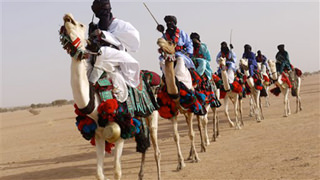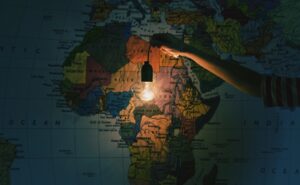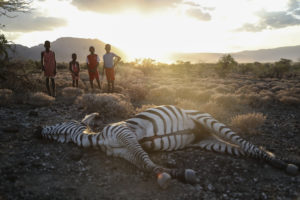Blue Man Coup: How Gadhafi’s Mercenaries Broke Mali
Everything that rises must converge, and in 2012, an uprising at the ancient crossroads of Timbuktu kicked up a decades-in-the-making sandstorm of global capitalism, US counterterrorism, cocaine smuggling and the long-denied rights of the most romantic nomads on earthAn uprising at the ancient crossroads of Timbuktu has kicked up a decades-in-the-making sandstorm of global capitalism, U counterterrorism, and the long-denied rights of the most romantic nomads on earth.
This is Part 1 of an in-depth look at the rebellion in Mali. Rebels seized the north of that country in March, throwing a relatively stable nation into chaos. As Susan Zakin explains, the conflict reveals a complex web of culture, ambition and unintended consequences. Part 2 will be published Thursday.
Everything that rises must converge, and in 2012, an uprising at the ancient crossroads of Timbuktu kicked up a decades-in-the-making sandstorm of global capitalism, U.S. counterterrorism, cocaine smuggling and the long-denied rights of the most romantic nomads on earth.
When outsiders come to Timbuktu in the West African nation of Mali, their first reaction is disappointment. Even Bruce Chatwin, the uber-traveler, called Timbuktu a “tired caravan city” where mud walls crumble to dust and all the color is sucked out by the sun. But the 12th century Saharan city has always carried the scent of adventure: Whether spelled Tumbuto, Tombouctou, Tumbyktu or Tembuch, Chatwin wrote, the name is a synonym for the remote and exotic. Inevitably, the reality must disappoint.
And yet. On April 1, when the Tuareg, the fabled blue men of the desert, captured Timbuktu, along with a hunk of northern Mali roughly the size of France, the world took notice. A military coup March 21 had thrown Mali’s government into disarray when well-armed Tuareg mercenaries from Moammar Gadhafi’s militia seized control of ancestral Tuareg lands in the Sahara — a remote region believed to contain some of the world’s last unexploited reserves of oil, gold and uranium.
Timbuktu, a capital of Africa’s 12th century golden age built on trading gold, salt and divine knowledge, once again became a bellwether for the commerce and culture of empires. And Mali, considered one of Africa’s most stable countries, faced an emergency that threatened to turn it into a failed state and the world’s next humanitarian crisis.
With French mercenaries circling like vultures around the corpse of a country once believed to be a thriving democracy, it’s disturbing to think that it all could have been avoided if Western nations hadn’t made their usual mistakes.
It’s a story straight from George Clooney’s stack of yet-to-be-produced screenplays: al-Qaida, global cocaine smuggling and a resource-rich African country crippled at birth by the International Monetary Fund and the World Bank. And the cast is rife with movie star charisma. The Tuareg are among the world’s last remaining true nomads. Their own name for themselves means “freemen.” The Tuareg are a warrior class, traditionally disdaining labor for sport and poetry. Roughly 5 million live in the desert regions of Niger, Mali, Algeria, Libya and Burkina Faso. Although they are Muslim, they are mostly Tuareg, with a matrilineal tradition (legend has it that they were led to the Sahara by a warrior queen in the fourth or fifth century). It is the men who veil their faces, in deep indigo, not the women.
Even the most blasé observers acknowledge that there is something special about the Tuareg, despite a propensity for certain less-than-savory practices, such as slavery and smuggling. Chatwin’s images are indelible: In the spectral gray backwater of Timbuktu, he saw “lean, aristocratic Tuaregs of supernatural appearance, with colored leather shields and shining spears, their faces encased in indigo veils, which, like carbon paper, dye their skin a thunder-cloud blue.”
Others are less romantic.
“They’re professional thieves,” said Peter Chilson, a professor at Washington State University who traveled to northern Mali this spring on a grant from the Pulitzer Center on Crisis Reporting. “We like that, don’t we? There’s a lot of romance about them, and the way they’ve managed to survive in the desert is sort of sexy by living off the Trans-Saharan caravan trade as guides and raiders. The technique was never to destroy these caravans, because that would destroy their livelihood, but to bleed them as they traveled back and forth. It’s the Tuaregs’ job and they’ve been doing it for a thousand years.”
Rebellion is also part of the Tuareg job description, first against the colonial French and later the post-colonial governments of Mali and Niger. Tuareg revolts show up in history like tree rings: 1904, 1916, 1962, 1990, 2006 and now 2012. Rebellion may be culturally hard-wired, but these rebels are not without a cause. Because the Tuareg prized honor above all, a ferocious and successful assault on such a foe could make a French military man’s career. As a result, French soldiers were particularly brutal to them, according to Bruce S. Hall in his book “A History of Race in Muslim West Africa, 1600-1960.” In post-colonial times, the Malian government continued the tradition by marginalizing the Tuareg, who do not have equal representation in government, and whose lands lack many basic services. Dashing as they are to Western eyes, nomads are regarded as second-class citizens by the region’s other ethnic groups.
In the 1980s, the Sahara’s salt caravans dwindled, and desertification made an already difficult way of life even more so. Gadhafi’s guerrilla training camps became pretty much the only gig available for Tuareg men in need of a job.
The Tuareg band Tinariwen, winners of a Grammy Award for best world music album this year, formed in one of Gadhafi’s camps, where young men from remote desert outposts discovered James Brown and Jimi Hendrix. It’s generally acknowledged that rhythm and blues derives from the music of West Africa, particularly Mali (Martin Scorsese described Malian Ali Farka Touré’s tradition as “the DNA of the blues”), so there is something both tidy and poetic about rock ‘n’ roll — the baby of the blues, to paraphrase Muddy Waters — recrossing the world to resonate with these desert rebels.Tinariwen’s members traded AK-47s for electric guitars back in the 1990s, but for most graduates of Gadhafi’s guerrilla training camps, life has been quite different. Tuareg fighters were the backbone of the Libyan leader’s militia, and when his regime fell in the summer of 2011, several thousand veteran Tuareg fighters suddenly found themselves unemployed. Their only capital was high-end armaments: mortars, antitank and antiaircraft weapons. In early 2012, they bore down on the north, declaring themselves the standard-bearers of a new liberation movement, the MNLA, or Mouvement National Pour la Liberation de l’Azawad — Azawad being the Tuareg name for northern Mali.
Like most observers, New York Times reporter Adam Nossiter linked the uprising directly to Gadhafi’s fall.
“In life, he delighted in fomenting insurgencies in the African nations to the south. And in death, Col. Muammar el-Qaddafi is doing it all over again,” wrote Nossiter.
Faced with Gadhafi’s professional and well-armed fighters, the Malian army quickly lost control. The army’s most humiliating moment came when the Tuareg overran one of its military bases in January — the soldiers had used up all of their ammunition, according to Jeremy Keenan, a professor at the University of London’s School of Oriental and African Studies who has spent much of his career in the Sahara.
On March 21, a cadre of junior officers staged a coup, installing Capt. Amadou Sanogo as the country’s leader. A lieutenant announcing the coup in halting French on national television denounced President Amadou Toumani Touré’s government’s “incapacity … to fight against the terrorists.”
It may be worth noting that Sanogo was trained in the U.S.; however, by most accounts, the coup was not backed by outside forces. Whatever its roots, far from strengthening the Malian military, the post-coup disarray gave an advantage to the rebels. They gained control of the region’s two major cities in March; Timbuktu fell April 1.
Spokesmen for the MNLA demanded recognition of an independent Tuareg state, but the African Union and the U.S. Department of State quickly rejected the idea. Privately, even MNLA sympathizers — including Tuareg in the U.S. — noted that the group had no formal structure or defined leadership. And for better or worse, the national boundaries drawn by the colonial powers have legal precedent, at least so far, for remaining intact.
The best-case scenario seemed to be a power-sharing agreement that would guarantee Tuareg leaders full participation in the Malian government. As one Tuareg said: “There’s a saying we have: Ask for more than you can get, and get what you want.”
Hope for a quick resolution receded when the situation in the capital city of Bamako grew increasingly uncertain. Unable to stamp out the coup, Touré, set to leave office after elections April 29, ceded power to the coup leaders April 8. A week later, under economic sanctions and the threat of military action by the Economic Community of West African States, Sanogo, the junta’s leader, handed power to Mali’s former parliamentary speaker and a presidential candidate, Diaconda Traoré, with the understanding that elections would be held in 40 days — if possible.
The bones of Mali’s democracy appeared intact when Traoré named Cheick Modibo Diarra, another leading presidential contender, as prime minister. Diarra, the chairman of Microsoft Africa, is an astrophysicist who once worked for NASA. But Diarra is a newcomer to politics, and his presence was not enough to prevent the military from arresting high-ranking allies of ex-president Touré. The men were freed, but as the weeks passed, it looked increasingly unlikely that the military would relinquish control. A counter-coup attempt by presidential guards, reportedly aided by mercenary soldiers, failed May 1. Four days later, radical Islamists of the Ansar Dine group associated with al-Qaida attacked a Sufi saint’s shrine in Timbuktu, confirming the fears of art historians and archaeologists that this century’s upheaval would jeopardize the ancient city’s cultural treasures.
The implosion of Mali was one of those unintended consequences that so often eclipse the goals of Western intervention. As Bajan Ag Hamatou, a lawmaker from Ménaka, complained to the Times’ Nossiter: “The Westerners didn’t want Qaddafi, and they got rid of him, and they created problems for all of us. When you chased Qaddafi out in that barbaric fashion, you created 10 more Qaddafis. The whole Saharo-Sahelian region has become unlivable.”
As onlookers fight to figure out who’s on first in Bamako, it’s easy to overlook the obvious question: What kind of army runs out of bullets? The answer is simple — an army in a country saddled with $3 billion in debt, corruption and cronyism.
Vijay Prashad, the George and Martha Kellner chair in South Asian history and professor of international studies at Trinity College in Hartford, Conn., recounts a tale that sounds familiar to anyone who follows Africa’s post-colonial history: A post-colonial socialist leader striving to make an African country self-sufficient in the 1970s was replaced by a less imaginative president who borrowed from the World Bank and the IMF when things got tough in the 1980s.
By the end of that decade, according to Prashad, Mali had become the “test case” for structural readjustment, the privatization initiatives and public-sector cutbacks that multilateral lending institutions such as the World Bank and the IMF have imposed on debtor nations for the past 20 years.
By 1989, Mali was spending 100.8 percent of its gross national product on debt service. By 1992, Mali’s debt had escalated to $3 billion. New York Times reporter Howard French quoted an associate of Mali’s president: “We service our country’s debt on time every month, never missing a penny, and all the time the people are getting poorer and poorer.”Mali’s president “begged the United States and Europe to either forgive the debt or restructure it,” Prashad wrote. “Washington held fast. Moral hazard was the name of the game. George Moose, Clinton’s assistant secretary of State for African affairs, caviled, ‘virtue is its own reward.’ How could Mali be bailed out? That would set a bad example for the rest of the indebted countries.”
Government salaries could not be paid and, presumably, ammunition could not be purchased. Forced privatization hurt the cotton market and decimated fragile farming in the north.
Without minimizing the damage of international lending policies, it would be both patronizing and inaccurate to hold the West entirely responsible for Mali’s troubles. David Gutelius, a development economist who worked in the region, criticizes development programs for lining the pockets of Mali’s politically connected elite without improving conditions for the poor. According to Gutelius, the lack of viable economic alternatives and government services in the northern desert was the result of the Traoré government’s cronyism, and helped foster successive Tuareg rebellions.
At the same time, Mali’s desperate financial situation left the country, which is 80 percent Muslim, dependent on Islamic nongovernmental organizations and missionary groups — including those dedicated to a “purer” Islam.
This is Part 1 of an in-depth look at the rebellion in Mali. Part 2, which will be published Thursday, picks up with the influence of religion, U.S. counterterrorism and smuggling on Mali’s ongoing crisis.
Your support matters…Independent journalism is under threat and overshadowed by heavily funded mainstream media.
You can help level the playing field. Become a member.
Your tax-deductible contribution keeps us digging beneath the headlines to give you thought-provoking, investigative reporting and analysis that unearths what's really happening- without compromise.
Give today to support our courageous, independent journalists.






You need to be a supporter to comment.
There are currently no responses to this article.
Be the first to respond.